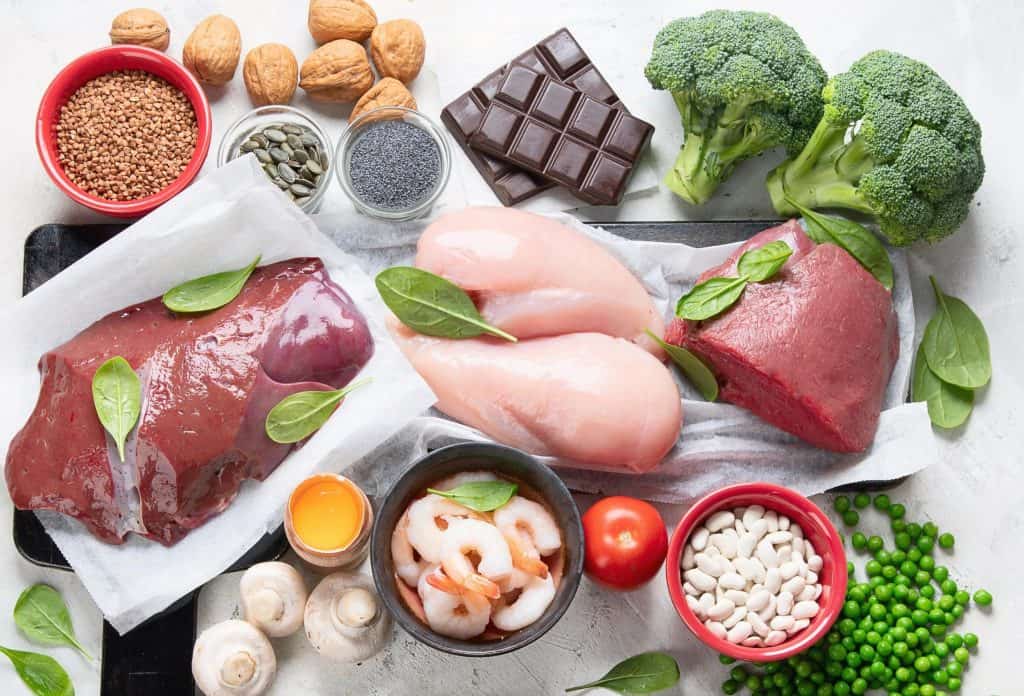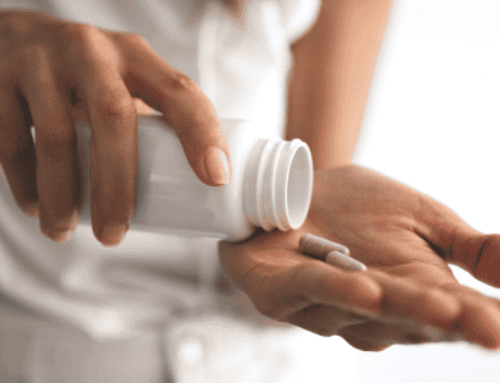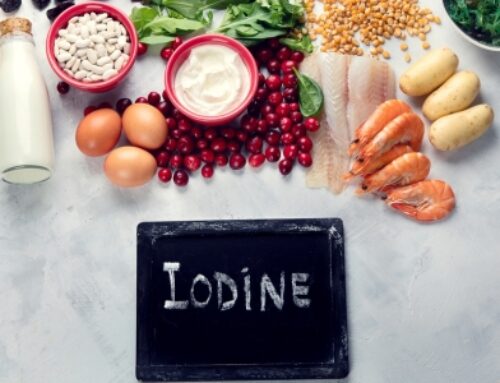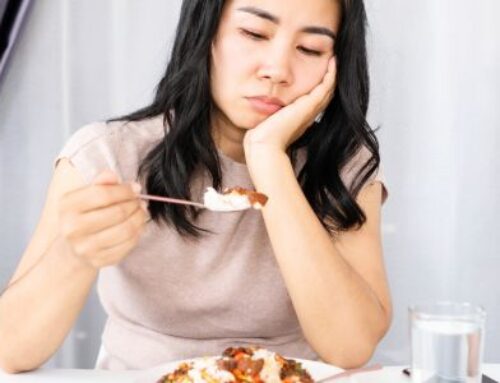
So, your GP has diagnosed you with an iron deficiency, but you aren’t sure what that means or where to go to from here. Read on to learn about the causes of iron deficiency, and some strategies that you can use to help to increase your iron intake.
What is an iron deficiency?
Iron has a variety of roles in your body. The most well-known is in a blood protein called haemoglobin, which helps transport oxygen around the body. Iron is also found in myoglobin, which supplies oxygen to the heart and muscles, and is required for energy production in the cells (1).
There are two types of iron deficiency: low iron stores in the form of low ferritin, a storage form of iron; and iron deficiency anaemia, where there is a lower amount of red blood cells produced due to a lack of iron to make haemoglobin.
Symptoms of an iron deficiency
Two thirds of the iron in our body is found in haemoglobin. When we don’t have enough iron to make haemoglobin, this can impact on our body’s oxygen carrying capacity, leading to feelings of fatigue and difficulty concentrating (2).
Other symptoms can include (3):
- Cravings for non-food items such as clay, dirt, or ice
- Hair loss
- Restless legs syndrome
- Brittle or bowed nails
- Poor growth and development in children (4)
What causes an iron deficiency?
Iron deficiency can be caused by low intake of iron relative to an individual’s iron needs, or loss of iron due to injury or illness.
Children, adolescents, and pregnant women have higher iron requirements due to growth demands and may be more susceptible to iron deficiency.
Some other examples of causes of iron deficiency include (5):
Low iron intake
- People who consume low amounts of meat due to difficulties chewing or swallowing
- Vegetarians and vegans – Read our article “Meeting Your Nutritional Requirements on a Vegetarian or Vegan Diet” for further information.
Low iron absorption
- Undiagnosed or poorly managed coeliac disease
- Some medications
- Gastrointestinal surgeries or illnesses
Blood loss
- Heavy menstrual cycles
- Frequent blood donations
- Inflammatory bowel diseases
- Loss of blood during surgery or following a major injury
How much iron do I need?
Iron requirements can vary depending on age, gender, and whether you are pregnant. Children and adolescents need higher amounts of iron to support growth and development, while pregnant women need more iron to support the growth of the foetus. Women have a higher requirement in adulthood to account for losses during the menstrual cycle. The requirements for iron are shown in the table below.
There are two values to consider when determining iron requirements: the Estimated Average Requirement (EAR) and the Recommended Dietary Intake (RDI). These two recommendations are based on the fact that individuals have different iron requirements. The EAR is the requirement for half of the individuals in a specific age or gender group, while the RDI is the requirement for nearly all the people (about 97-98%) in that age or gender group.
In Australia, the requirements are (2):
Girls/Women
| Age | EAR | RDI |
| 7-12 months | 7mg/day | 11mg/day |
| 1-3 years | 4mg/day | 9mg/day |
| 4-8 years | 4 mg/day | 10mg/day |
| 9-13 years | 6mg/day | 8mg/day |
| 14-18 years | 8mg/day | 15mg/day |
| 19-50 years | 8mg/day | 18mg/day |
| >51 years | 5mg/day | 8mg/day |
Boys/Men
| Age | EAR | RDI |
| 7-12 months | 7mg/day | 11mg/day |
| 1-3 years | 4mg/day | 9mg/day |
| 4-8 years | 4 mg/day | 10mg/day |
| 9-13 years | 6mg/day | 8mg/day |
| 14-18 years | 8mg/day | 11mg/day |
| >19 years | 6mg/day | 8mg/day |
What is the best source of iron in our diet?
Red meat is well known as a rich source of iron, and other animal proteins are also rich in iron. This is because they have a high amount of iron bound up in the proteins, called haem iron. Haem iron is easily recognised and absorbed by our bodies.
Sources of haem iron include:
- Lean red meats such as beef, lamb, pork, or kangaroo
- Poultry meats such as chicken and turkey
- Fish and seafood such as oysters, sardines, salmon, and tuna
- Eggs
Red meats that are leaner, or have less overall fat content, will have proportionately more iron than a very fatty red meat, such as sausages or high fat mince. If you do choose to eat red meat, opt for a leaner cut instead.
Does that mean I have to eat red meat?
No! Animal-based sources of iron are not suitable for everyone. For example, those with egg or seafood allergies, people who aren’t keen on the taste of red meat, or those who prefer to eat a plant-based diet will have fewer varieties of iron rich foods in their diet.
Plant-based sources of iron, referred to as non-haem iron, are another way to increase your iron intake.
Examples of non-haem iron sources are:
- Iron fortified breakfast cereals such as Weet-Bix or All-Bran
- Legumes including kidney beans, chickpeas, or lentils
- Dried apricots
- Cooked wholemeal pasta or brown rice
- Tofu
- Broccoli
- Spinach
These sources of iron are not readily absorbed by our bodies as the iron is in a different form that our bodies don’t easily recognise. Consuming a food high in Vitamin C with a non-haem source of iron will help to convert the iron into a more readily absorbed form, increasing the amount of iron your body can use from that food.
Sources of Vitamin C include (6):
- Citrus fruits
- Strawberries
- Tomatoes
- White potatoes
- Capsicums
- Cruciferous vegetables such as cauliflower, broccoli, cabbage, rockmelon
When to take an iron supplement
If you suspect that you have an iron deficiency, it is best to consult with your GP. Your doctor will order a blood test to confirm whether you are iron deficient.
It is important to confirm whether you have an iron deficiency with a GP prior to using a supplement, as iron supplements, particularly those with a higher dosage, can have unpleasant side effects. A GP can decide the best dosage and type of iron supplement for you and assess and treat the underlying cause of the iron deficiency.
Once an iron deficiency has been confirmed, a dietitian can work with you on practical dietary strategies for increasing iron intake, considering your food preferences and lifestyle.
Do you think you are iron deficient and would like guidance and support to improve your overall iron intake?
Our lovely dietitian Sian Hopkins would love to help!
References
- Abbaspour N, Hurrell R, Kelishadi R. Review on iron and its importance for human health. J Res Med Sci. 2014;19(2):164-174.
- Nutrient Reference Values for Australia and New Zealand, Including Recommended Dietary Intakes. NHMRC. September 9, 2005. Accessed February 15, 2022. Available from: https://www.nrv.gov.au/sites/default/files/content/n35-iron_0.pdf
- Auerbach, M. and Adamson, J.W. (2016), How we diagnose and treat iron deficiency anemia. Am. J. Hematol., 91: 31-38. https://doi.org/10.1002/ajh.24201
- Vitamin C: Fact Sheet for Health Professionals. National Institutes of Health. March 26, 2021. Accessed February 18, 2022. Available from: https://ods.od.nih.gov/factsheets/VitaminC-HealthProfessional/
- Robert D. Baker, Frank R. Greer, The Committee on Nutrition; Diagnosis and Prevention of Iron Deficiency and Iron-Deficiency Anemia in Infants and Young Children (0–3 Years of Age). PediatricsNovember 2010; 126 (5): 1040–1050. 10.1542/peds.2010-2576
- Clara Camaschella; Iron deficiency. Blood2019; 133 (1): 30–39. Doi: https://doi.org/10.1182/blood-2018-05-815944



